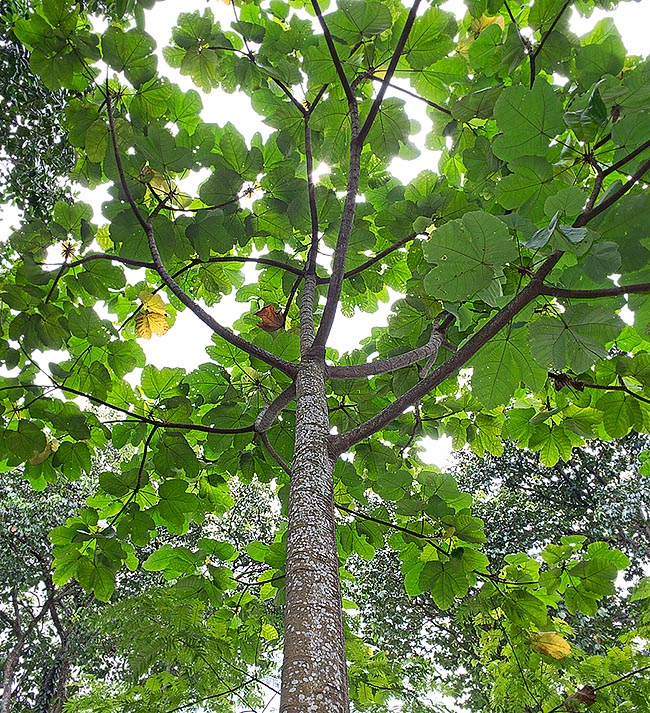Family : Euphorbiaceae

Text © Pietro Puccio

English translation by Mario Beltramini

Native to South-East Asia, Macaranga gigantea is a fast growing dioecious evergreen tree, with fruits loved by the birds who then care their dispersion. Parts of plant are utilized in the traditional medicine for various pathologies. The large leaves contain bioactive compounds with antibacterial and antioxidant properties © Giuseppe Mazza
The name Macaranga is that in use in Madagascar to indicate a species belonging to the genus; the specific name is the Latin adjective “giganteus, a, um” = gigantic, with reference to the great leaves.
Common names: elephant ear tree, spotted tongue (English); jela bung-bung (Indonesian); kubin, mahang, menku- bong, selaru (Malay).
The Macaranga gigantea (Rchb.f. & Zoll.) Müll.Arg. (1866) is an evergreen dioecious tree, up to about 25 m tall, with greyish smooth bark from whose wounds exudes a reddish sap.
The leaves, on a pubescent petiole flattened above, 20-45 cm long and of 1 cm of diameter, are simple, alternate, peltate, 20-60 cm long and broad, trilobed, possibly with two more small lobes near the base, with toothed margins and pointed apex, coriaceous. The lower page, with prominent nervations, is densely covered by a silvery tomentum; moreover, are present extrafloral nectaries on the margins close to the junction to the petiole.
Axillar inflorescences, the male ones panicle, erect, 20-50 cm long, covered by silvery or reddish tomentum with scattered groups of hairs, ovate bracts with pointed apex, 0,5-1 cm long, pubescent, ovate bracteoles, 0,5 cm long, with irregularly toothed margins, subtending groups of 6-15 green flowers, 1 mm long, with 3 free sepals and 2-3 stamina. Panicle female inflorescences, erect, compact, 10-25 cm long, covered by silvery tomentum, ovate bracts about 0,4 cm long, 2 mm long flowers with urceolate (shaped like an urn) calyx and 1 mm long style.
The fruits are capsules, about 0,5 cm long and 0,7 m broad, with two yellowish sub-globose lobes; 4 mm diameter lenticular seeds, of black colour, provided with purple fleshy aril. It easily reproduces by seed in sandy loam maintained humid at the temperature of 24-26 °C.
Fast growing pioneer species particularly suitable for the reforestation of degraded areas, produces a remarkable quantity of fruits particularly appreciated by the birds who then disperse their seeds, becoming in a few years the dominant species. It exclusively grows in the tropical and humid subtropical climate zones, in full sun, on preferably sandy soils, even poor, with ample availability of water. The wood has a limited utilization in the civil constructions for inner parts and from the sap they get a red dye.
Parts of the plant are utilized in the traditional medicine for various pathologies, laboratory studies have evidenced the presence in the leaves of bioactive compounds with antioxidant and antibacterial properties.
Synonyms: Mappa gigantea Rchb.f. & Zoll. (1858); Mappa macrophylla Kurz ex Teijsm. & Binn. (1864); Mappa megalophylla Müll.Arg. (1864); Rottlera gigantea (Rchb.f. & Zoll.) Rchb.f. & Zoll. ex Kurz (1864); Mappa rugosa Müll.Arg. (1865); Macaranga megalophylla (Müll.Arg.) Müll.Arg. (1866); Macaranga rugosa (Müll.Arg.) Müll.Arg. (1866); Tanarius giganteus (Rchb.f. & Zoll.) Kuntze (1891); Tanarius megallophyllus (Müll.Arg.) Kuntze (1891); Tanarius rugosus (Müll.Arg.) Kuntze (1891); Macaranga incisa Gage (1922).
→ To appreciate the biodiversity within the family EUPHORBIACEAE please click here.
